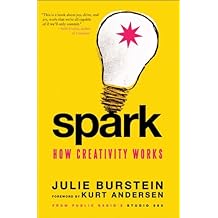![Spark: How Creativity Works by [Andersen, Kurt, Julie Burstein]](https://images-na.ssl-images-amazon.com/images/I/513IIHvfv%2BL.jpg) The meat of Spark is, of course, the perspective and experiences of the artists themselves, but Julie Burstein, who produced the radio show and compiled the interview excerpts, offers a few insights into the creative process from her own experience. Here, she’s recounting part of a conversation with her mother, a college professor and author.
The meat of Spark is, of course, the perspective and experiences of the artists themselves, but Julie Burstein, who produced the radio show and compiled the interview excerpts, offers a few insights into the creative process from her own experience. Here, she’s recounting part of a conversation with her mother, a college professor and author.
“My mother often reminds me that beginning a new project doesn’t start when you sit down at your desk to write, or stand in front of a canvas with a palette full of paint, or figure out a new tune on a piano. For most creative work, there’s a period that she likes to call ‘pawing the earth,’ when we must create the environment in which we can begin.”
– Julie Burstein, radio producer and author

 I’m continuing to quote from Spark this month.
I’m continuing to quote from Spark this month. This month, I’m sharing a few of my favorite observations from Spark: How Creativity Works by Julie Burstein (Harper Collins, 2011), based on interviews conducted for Public Radio’s Studio 360, by Kurt Andersen and produced by Burstein.
This month, I’m sharing a few of my favorite observations from Spark: How Creativity Works by Julie Burstein (Harper Collins, 2011), based on interviews conducted for Public Radio’s Studio 360, by Kurt Andersen and produced by Burstein.